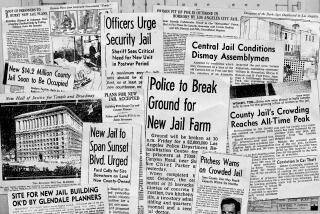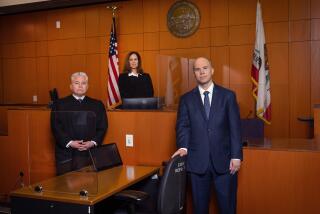Trial Setting : County Judges Take Center Stage as Auditorium Turns Courtroom
- Share via
If all the world’s a stage, then can’t a courtroom be one too?
A stage, in fact, will be a courtroom this summer in Santa Monica as Superior Court turns to a high school auditorium for partial relief of a critical space shortage plaguing the county judicial system.
Starting this week, Superior Court is using Santa Monica High School’s Art Deco Barnum Hall--the site of concerts and school plays--for a series of civil trials.
County workers have renovated theatrical dressing rooms to serve as jury rooms and judges’ chambers by sweeping out cobwebs and applying coats of white paint over old graffiti, while benches and tables have been erected on stage for the trials. (A panel of actors’ autographs was spared the paint job.)
At one point, even the school’s theatrical department was going to get in on the act by having summer drama students build backdrops to make the stage look more like a courtroom. That idea was shelved, however, because of costs.
The Santa Monica court’s use of the auditorium is the brainchild of Judge Richard G. Harris, who has worked in the jurisdiction for seven years.
It is one of the more novel approaches to a countywide space shortage. As caseloads have grown, so have delays in trials and the need for more courtroom space, officials say.
“There are instances in which we conduct court in something less than a courtroom, varying in size and suitability,” said Eric Webber, chief deputy county clerk executive officer of the Superior Court. “But because of the growth in the system and the lack of courtrooms, we’ve had to make do.”
Already, Santa Monica judges hear some cases in trailers, and elsewhere in the system, courts have used closet-sized offices and even a cafeteria for proceedings.
Webber said Santa Monica’s use of an auditorium is only a stopgap. But, he added, “every little bit helps.”
Leasing Office Space
As for more long-term, if unconventional, solutions, the court system is negotiating plans to lease commercial office space that would be used for 48 permanent courtrooms, Webber said. Officials say leasing courtroom space is a less expensive and quicker alternative to building more courthouses.
A wide-ranging courthouse-expansion blueprint, which details plans for the leasing and construction, goes before the County Board of Supervisors next week.
“We are in a situation where we need additional courtrooms, and we need them quickly,” Webber said. “It’s critical that the system expand.”
Court officials estimate that, given the rate at which dockets are growing, the court system must expand 50% by the year 2000 to maintain the current level of service.
Harris came up with the idea of using the auditorium last year when he was looking for a place to accommodate what was expected to be a long jury trial involving the owners of the Los Angeles Clippers basketball team. (Litigants eventually waived the trial.)
Harris considered the buildings near the courthouse; RAND Corp. offices were filled, so it became a choice of either the school’s auditorium or the city’s bowling alley, he said.
Neglected Theater
The school agreed to lend its auditorium, a somewhat neglected theater built in 1937 as part of President Franklin Roosevelt’s Work Projects Administration. It was not scheduled for use over the summer.
Although the verdict is not yet in on how people involved in the trials will react to the makeshift courtroom, Harris said he does not anticipate any objections.
“They might not like being on a stage, but it’s better than a (bowling) alley, and it gets their case heard,” he said. “The trick in this game is getting a firm date, a date you can believe in. This helps them get to trial.”
Harris sang the praises of the Santa Monica-Malibu Unified School District for agreeing to lend the courts space for the project, and school officials said they, too, were happy with the arrangement.
“It’s a situation of one public agency assisting another public agency,” said Tim McNulty, acting assistant superintendent of business and fiscal services.
The court is picking up all the expenses, such as custodial fees, insurance and utilities, and the school system has waived rent. Harris said he hoped 10 to 15 trials could be completed during the summer.
Retired Judge Charles Loring is presiding over the first trial-on-stage. He is involved in a separate program to recruit retired judges to hear some cases.
Costly Class Project
The one disappointment so far has perhaps been the decision by the drama department not to participate.
Frank Ford, the teacher who heads the drama department, had hoped the students could build props to create a “theatrical illusion” of being in a court.
But he found he did not have enough flats--wood-and-canvas screens used as backdrops--and building more would be too expensive and time-consuming for the students.
The result may be a courtroom that is a little more primitive than first envisioned. But that may be part of the stage world.
“The dignity of the court may be better maintained through the characters involved than through (scenery),” Ford said. “Anyone who’s been on stage realizes that it’s all an illusion, anyway.”
More to Read
The biggest entertainment stories
Get our big stories about Hollywood, film, television, music, arts, culture and more right in your inbox as soon as they publish.
You may occasionally receive promotional content from the Los Angeles Times.











